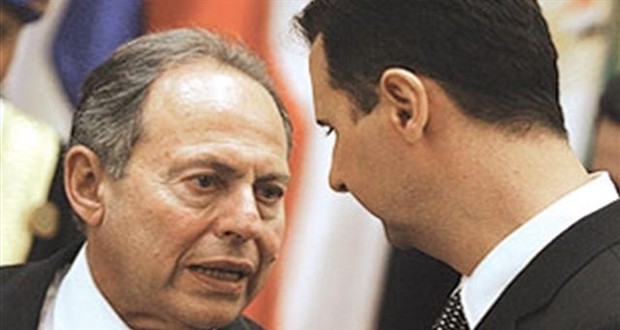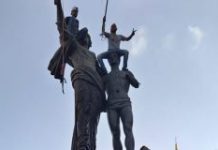The Crisis of the Assad Regime
Jeffrey White/Washington Institute
May 28, 2015
Damascus faces a long decline unless major factors change relating to regime strategy, additional resources from allies, or a collapse in rebel unity of effort.
Last week, the Bashar al-Assad regime suffered two significant defeats at the hands of two different armed opposition forces: the first to the Islamic State of Iraq and al-Sham (ISIS) at Palmyra in eastern Homs province, and the second to Jaish al-Fatah forces, to which it lost its last major foothold in Idlib province. While these defeats do not signal the regime’s imminent demise, they do indicate that the war is running against it and that a long recession has likely begun, leading to the state’s collapse or contraction.
The regime and its allies will fight back and will likely have some successes on some fronts of the war, but after more than four years of fighting basic factors in the conflict are tilting against the regime and the regime’s capacity to redress the balance. It would require major changes in the situation for this to be stopped or reversed, including: a shift to a strategy of consolidation, a significant increase in commitment of forces by the regime’s allies, reversing the upward trend in rebel capabilities, or outside diplomatic intervention to freeze or resolve the conflict.
The Elements of Regime Military Failure
Analysis of the fighting points to five major factors behind the regime’s military decline.
Failing strategy. The regime’s military strategy has hinged on its abilities to bring about greater attrition for its enemies, mobilize greater resources, and hold key positions. This approach has previously served the regime reasonably well, but as indicated above, it has begun to fail; adherence to it is costing the regime significantly. In particular, the regime spreads its forces thinly, leaving them exposed to isolation and defeat, while boosting the strength of its enemies.
Failing operations. Regime forces are failing at the operational level. Offensives southwest of Damascus and around Aleppo this spring produced small gains with substantial regime casualties. Defensive operations in Idlib and eastern Homs were unsuccessful, leading to the loss of major positions, again with substantial regime casualties and loss of weapons and ammunition. An exception is the current offensive in the Qalamoun area, which relies primarily on Hezbollah forces, planning, and determination. Regime forces are strictly in a supporting role here, providing airstrikes and artillery support but not engaged in serious ground combat.
Failing forces. Along with faltering operations, regime forces are being outfought in individual actions. Regular army units and irregular units alike appear to lack offensive spirit and are even showing signs of halfhearted defense. And even strong defensive positions such as Wadi Daif and Hamadiya and the Mastumah military camp in Idlib province have fallen surprisingly quickly. The old tactical formulas built on superiority of heavy weapons and airpower are no longer yielding the same positive results. Regime units such as Republican Guard formations, the “Tiger Force,” and the “Desert Hawks” are still capable of serious fighting, but these represent probably less than 10 percent of Syrian forces and have only a limited capability to affect the broad military situation.
Improving opponents. Regime opponents are much more capable than in late 2012, the last time they seriously threatened the regime.
While the regime still enjoys advantages in terms of aircraft, heavy armor, and artillery, opposition forces are now heavily armed with weapons taken from regime forces and some key systems (e.g., antitank guided missiles) provided from external sources. Major rebel offensive actions are normally “combined arms” affairs featuring tanks, artillery, mortars and other heavy weapons working with infantry.
Coordination and cooperation among rebel forces, especially in the north and south, has also improved significantly. The rebels are acting in concert at times, in places, and on a scale they could not before. The Islamist Jaish al-Fatah in Idlib province and its allies, and the Southern Front in the south, are the best examples of this. To this must be added the ability of ISIS, also known as the Islamic State, to implement its own strategy with well-conceived operations against regime forces in the east. Never before in the war has the regime faced capable and coherent forces in the east, north, and south.
Rebels have become better at taking regime positions and keeping the ones they have. In the Idlib offensive, the rebels seized a number of regime tactical defensive positions, from small checkpoints to major strongpoints, as well as urban areas (Idlib, Jisr al-Shughour, Ariha) long held by the regime. This indicates improving operational and tactical performance by rebel forces based in part on better arms and better ability to coordinate their use, but also on the improving fighting qualities of rebel units. In terms of discipline, cohesion, leadership, and motivation, some rebel forces and ISIS forces in general appear superior to regime regular and irregular forces. This generally translates to defeat in battle for regime forces, except where high-quality regime units or allied forces are present.
Armed opposition logistics, a traditional weak point, appear to have improved to the point of allowing sustained offensive operations. This is a result of improved foreign assistance, reportedly from Turkey, Saudi Arabia, and Qatar, and the opposition’s ability to acquire substantial amounts of arms and ammunition from regime forces as a result of battle. Most of the opposition’s heavy weapons have been acquired through capture either in Syria or, in the case of ISIS, Syria and Iraq.
Failure in battle. The regime has been performing less well in battle, except where it is either supported by allied forces or allied forces are in the lead, as in the ongoing Hezbollah-driven Qalamoun operations.
As noted, the regime has suffered a string of recent important defeats in Idlib province to a coalition of rebel forces dominated by Islamists, and in eastern Homs province to ISIS. In both cases, the regime’s opponents carried out operations involving a sequence of battles to inflict strategic defeats on the regime. In Idlib, the operation involved successful battles for Idlib city, Jisr al-Shughour city, and Ariha city. In eastern Homs, regime forces were defeated by ISIS at Sukhna and Palmyra.
Net effect: declining regime capabilities. Regime military capabilities are on the decline. Intervention by its allies has prevented this trend from becoming fatal, but that may be unsustainable. Only where Hezbollah troops are directly committed to combat does the regime enjoy offensive success, and as the early spring 2015 fighting southwest of Damascus showed, not even that guarantees success. Defensively, the regime does better, but it has had significant failures in recent defensive battles in Idlib, Homs, and Deraa provinces.
Game Changers
The war in Syria has been characterized by many twists and turns: The rebels looked near defeat in early 2012, the regime near defeat in late 2012. The regime fared well in 2013 and part of 2014, and is now failing in 2015. While the regime looks set for a long recessional ending, its position could still be improved by certain variables.
The regime could change its strategy by withdrawing forces from vulnerable positions in areas not of critical military importance. This would include its forces in Hasaka and Deir al-Zour provinces, and those in the salients in Deraa and Idlib provinces, and perhaps even Aleppo province. The troops and resources freed up could be used to bolster defenses in more important areas or for offensive operations. This consolidation, representing a major change in regime strategy, would mean the sacrifice of three to four provincial capitals and local forces working with the regime. While politically unpalatable, it may well become necessary.
The regime’s allies could, in turn, provide additional forces to offset its losses and enhance its fighting qualities. Hezbollah secretary-general Hassan Nasrallah’s May 24 speech seemed to indicate a willingness to commit more forces, and opposition sources claim Hezbollah has already increased its forces in Syria. Iran could potentially arrange for more personnel from Iraq, Afghanistan, and elsewhere, and could commit more of its own personnel. Such steps could stabilize the regime’s military situation and, with still greater numbers, allow it to go on the offensive. Yet the regime’s external opponents could offset Syrian gains by boosting their own support to the rebels.
Central to recent rebel success has been increased unity of effort. If this collapses, the rebels will be less capable of successfully mounting serious operations against the regime. But the regime cannot easily effect such an outcome through its own devices. And whatever happens to other opposition forces, ISIS will remain highly purposeful and effective.
The regime could also benefit from a serious negotiating process, especially one that includes a ceasefire and allows it time to rest, refit, and realign its forces. The eagerness of many in the West and the United Nations to achieve a “political solution,” and the potential for sheer exhaustion among the Syrian people and combatants, suggests this is at least a possibility.
Outlook and Conclusion
In the near term, the regime will likely see further setbacks in Idlib and eastern Homs provinces, with the situation in Homs being the more serious. Should ISIS decide to seize the regime’s positions in Deir al-Zour, it will likely succeed in wresting the entire province from the regime.
The midterm could see the decline or loss of the regime’s position in western Aleppo province, and further erosion of its position in northern and eastern Hama province. Regime defeat in Aleppo, although the biggest potential blow, would not necessarily mean the war’s end.
In the long term, the war will increasingly impinge on core regime-held areas, including Latakia province, western Hama and Homs provinces, and locations in and around Damascus city. The regime will try hard to hold these places, and rebel victories will come hard, especially if the regime’s allies provide reinforcements.
The regime’s short- and even long-term prospects seem dim, even as it could still be saved by some combination of the factors discussed earlier. Most likely is a long decline characterized by lost battles, lost positions, and unrecoverable attrition. Regime opponents, meanwhile, seem set for a long war and increased success on Syria’s battlefields.
U.S. policymakers are given to saying the Syrian conflict has no military solution, but in fact such a “solution” is emerging. Some combination of the regime’s armed opponents will likely win — that is, drive the regime out of existence or perhaps into a Hezbollah-protected rump state on the Mediterranean coast. Eventually, the regime’s opponents could move to destroy this rump state, which would likely be unstable and unviable.
Military developments will create a new political situation in Syria that the winners, likely excluding Assad, will need to sort out. Exactly what this political situation will resemble is impossible to say, but it will be complex and most likely violent.
**Jeffrey White is a defense fellow at The Washington Institute and a former senior defense intelligence officer.


















